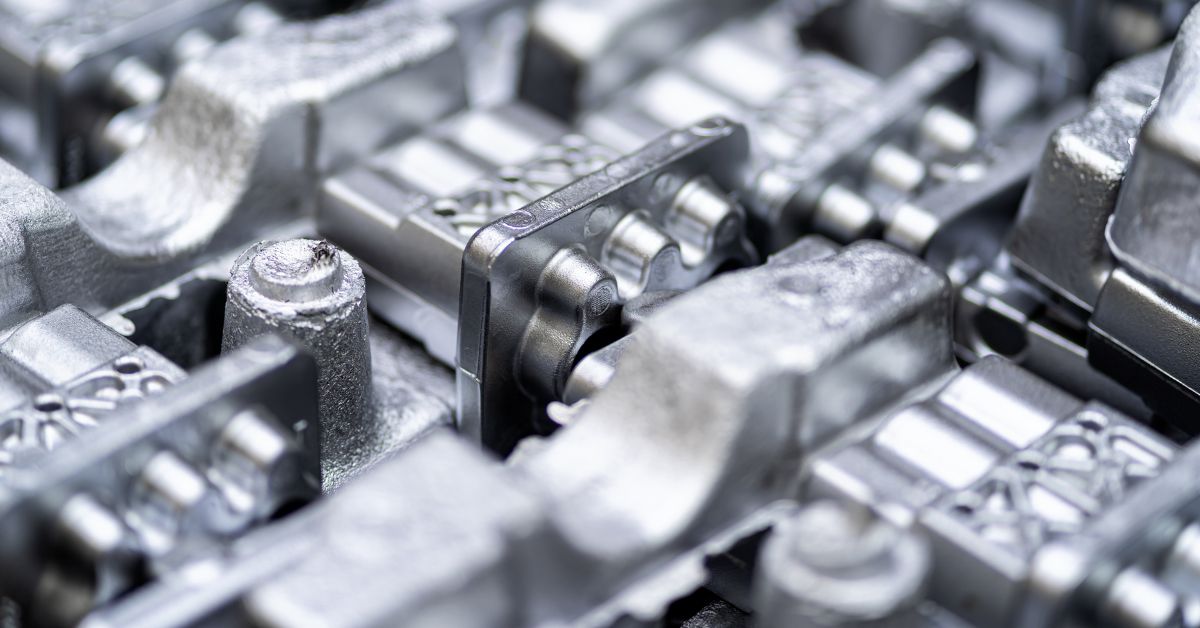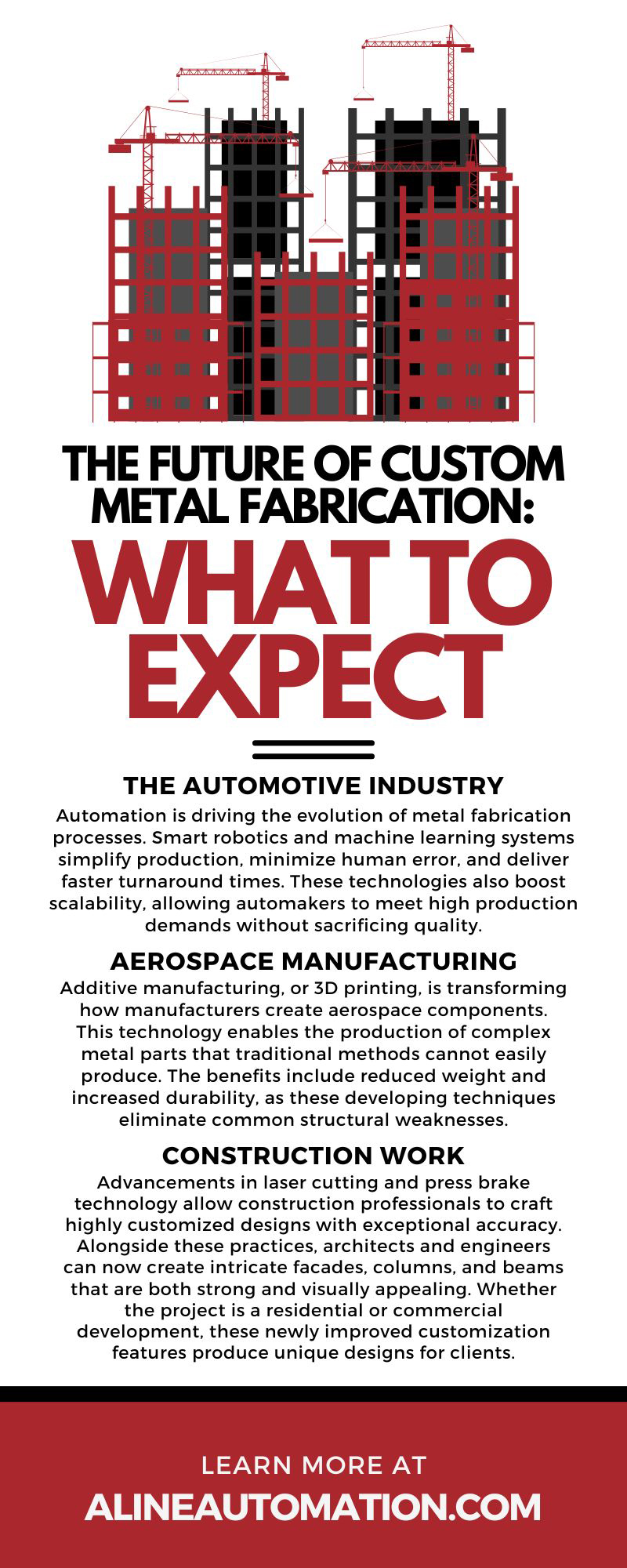
Custom metal fabrication continues to evolve as many industries demand more advanced, efficient, and precise solutions. Understanding the future trends in this field allows product designers and manufacturers to stay competitive and meet market demands. Find out what to expect from the future of custom metal fabrication and how you can use these resources to benefit your upcoming projects.
The automotive industry relies on custom metal fabrication to produce high-quality, durable vehicle components. The future holds exciting innovations that will make these resources safer and allow for more personalized mechanisms for consumers.
Advancements in laser cutting and AI technologies are enabling automakers to create complex geometries with greater precision and finer tolerances. These improvements result in lighter, safer components that improve vehicle performance.
The use of lightweight alloys such as aluminum and titanium further supports the industry's push for fuel efficiency and sustainability. With these resources, automotive industries can offer exceptional strength-to-weight ratios while reducing environmental impact.
Automation is driving the evolution of metal fabrication processes. Smart robotics and machine learning systems simplify production, minimize human error, and deliver faster turnaround times. These technologies also boost scalability, allowing automakers to meet high production demands without sacrificing quality.
The aerospace industry uses custom metal fabrication to build aircraft that meet stringent safety and performance standards. Future advancements in fabrication technologies will improve performance, reduce costs, and support innovation.
Additive manufacturing, or 3D printing, is transforming how manufacturers create aerospace components. This technology enables the production of complex metal parts that traditional methods cannot easily produce. The benefits include reduced weight and increased durability, as these developing techniques eliminate common structural weaknesses.
Innovations in material engineering are also driving new possibilities for custom metal fabrication. For instance, ultralightweight alloys and composite materials improve fuel efficiency and extend flight ranges. Advanced heat-resistant materials tackle extreme conditions in engine systems and outer-space applications for reliability across multiple flight cycles.
The integration of data-capturing techniques into fabricated parts is revolutionizing predictive and preventative maintenance. By embedding sensors into metal structures, this makes real-time monitoring of component health possible and reduces downtime and maintenance costs. This proactive approach guarantees timely repairs and prevents failures to enhance overall operational efficiency.
The construction industry has always been one of the largest consumers of fabricated metal, and its future continues to look ambitious as custom metal fabrication advances. Builders and architects can expect great changes in the future of custom metal fabrication and look forward to the benefits it provides.
Advancements in laser cutting and press brake technology allow construction professionals to craft highly customized designs with exceptional accuracy. Alongside these practices, architects and engineers can now create intricate facades, columns, and beams that are both strong and visually appealing. Whether the project is a residential or commercial development, these newly improved customization features produce unique designs for clients.
Metal fabrication promotes eco-friendly building practices with the use of recyclable and reusable metals. With the rising trend of green initiatives, these advancements help reduce material waste and align with environmentally sound construction goals. This development grants construction workers the ability to meet stricter environmental regulations in their local area.
Cutting-edge manufacturing methods are improving work performance in construction with prefabricated metal structures. These techniques, including modular and hybrid metal fabrication, enable faster on-site assembly, reduce timelines, and improve the safety and reliability of final structures through standardized components.
Medical technology relies on exceptional precision, biocompatibility, and functionally integrated materials for patients and research studies. Modern metal fabrication techniques will further improve treatments and expand the possibilities for medical applications.
The increasing demand for surgical instruments and implants relies on custom laser cutting and CNC machining. These evolving techniques deliver finer tolerances and detailed finishes to ensure medical devices meet complex patient needs. High-precision fabrication simplifies integration with the human body, improving both patient comfort and recovery times.
Biocompatible alloys and shape-memory materials reconstruct medical implants for better application. Custom alloy fabrication reduces rejection risks while securing long-term durability.
Shape-memory alloys also allow for minimally invasive procedures by creating tools and implants that adapt to the body’s structure. This transforms patient care and surgical possibilities and boosts future treatment success rates.
AI and robotics are valuable assets for the production of customized medical tools and implants. Automated fabrication processes, powered by AI-driven data, enable scalable production without sacrificing personalized patient requirements or extensive testing trials. This approach reduces costs to advance the future of medical care.
Electronics manufacturing requires precision, conductivity, and durability for high quality products. This makes custom metal fabrication an integral part of this fast-evolving industry. Innovations in this sphere will set new benchmarks for design and operational efficiency.
Metals such as copper, silver, and gold used in electronics require precise fabrication methods. With the help of innovations in plasma and laser cutting, these techniques allow manufacturers to achieve the micro-level precision needed for modern devices. This improved accuracy will promote device functionality and longevity.
Custom alloy manufacturing is also leading to improvements in conductive materials. Newly manufactured conductive resources boost performance in heat sinks, circuit boards, and semiconductors. At the same time, durability upgrades will reduce wear-and-tear issues in consumer electronics, thereby extending product lifespans and cutting down on e-waste.
Fabrication processes use additive manufacturing to produce compact, high-performance components. This is particularly beneficial for wearable devices and IoT products, which demand lightweight, functional designs. The next phase of custom metal fabrication will meet rising consumer expectations for performance, design, and sustainability.
Plan for the future of metal fabrication by partnering with our team at A-Line Automation. For manufacturers and construction companies, we use custom aluminum profile fabrication methods that can adapt to evolving industry needs. If you’re looking for durable materials for your next project, browse our selection or contact our team for customized support today.
